
Seismic energy from a major meteorite impact would be expected to disrupt the surface on the opposite side of the Earth.2,13 The different types of wave phases are shown below.7 "In a perfectly spherically symmetrical structure, waves arrive simultaneously from all directions and focus exactly at the antipode. As a consequence of the 3-D heterogeneity in the Earth, waves coming to the antipode from different directions do not arrive exactly simultaneously. These differences in traveltimes of waves coming from different directions distort the perfect focusing". P-waves, especially PP and PKPab, are strongest and most focused, while S-waves tend to be more disturbed by heterogeneities in the Earth.7
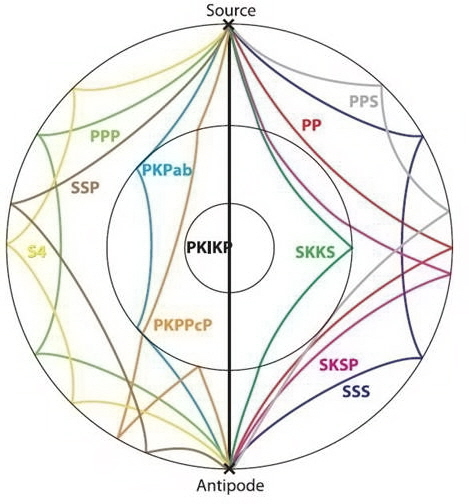
Computer simulations conducted at Sandia National Laboratories in 1994 produced the wave paths shown here.2
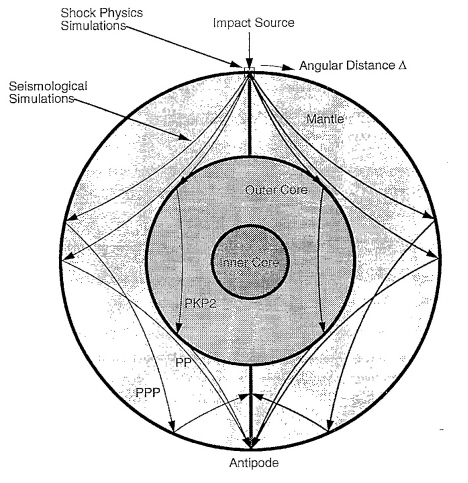
How much disruption would be caused has been debated among researchers. Some argue that volcanic "hotspots" and even flood basalts could be triggered by antipodal effects,3 while others find the energy reaching the antipode to be insufficient to cause volcanism.4 Disrupted terrain, and possibly volcanism, are thought to have been found antipodal to large impact craters on the Moon, Mars, and Mercury.13,15
For example, drawing a line from the center of the enormous impact basin Hellas on Mars
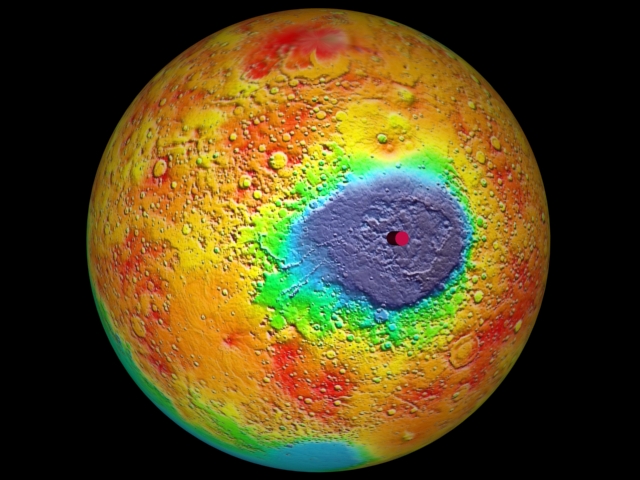
through the center of the planet
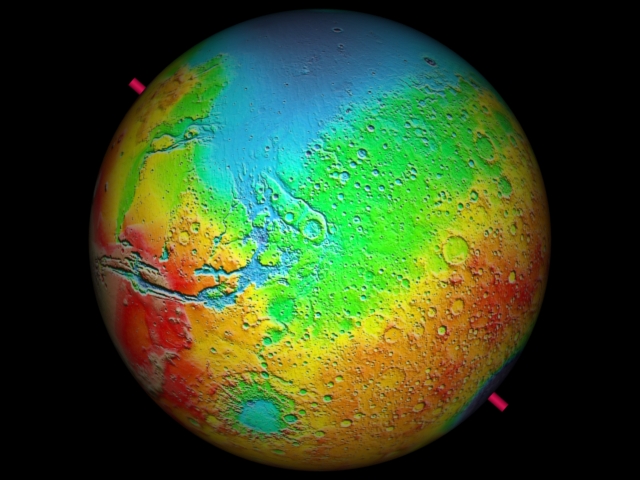
comes out in the center of Alba, the largest volcano on Mars. It is 1600 km across, and although fairly flat, it produced great volumes of lava.
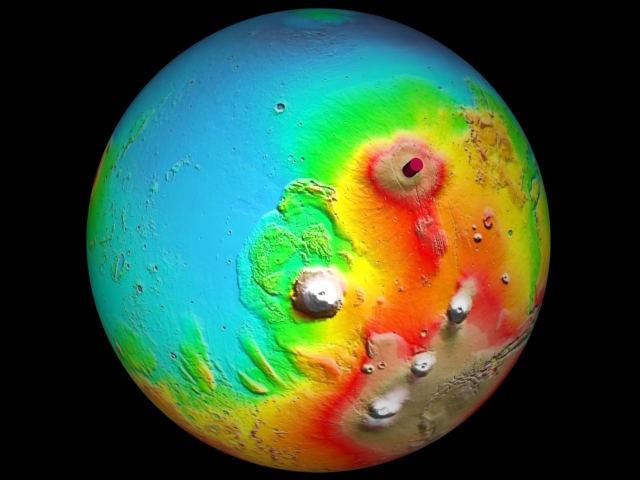
A planet like Earth, with a molten outer core and a solid mantle will focus seismic waves to maximize antipodal pressure.14 The energy released by the Shock Dynamics impact is estimated to have been at least 200 times that of the Chicxulub impact, and should have affected a large area.
The Shock Dynamics meteorite apparently struck at an oblique angle, probably near 30 degrees, and along an east-southeast (ESE) azimuth. This is based on three observations: 1) A huge tektite strewnfield attributed to no other meteorite extends east from the impact site.
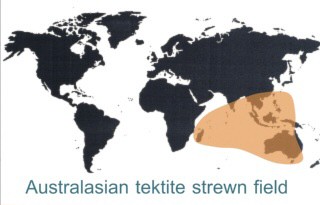
2) The Bonin-Mariana and Tonga-Kermadec Trenches override Pacific crust from west to east, and are interpreted in the Shock Dynamics model to be halves of a frozen crustal wave launched eastward from the front of the oblique impact.
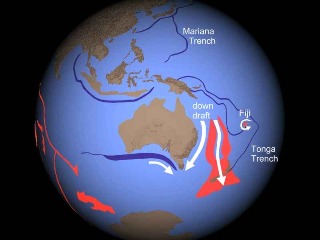
3) The central uplift of the crater has a U-shape (characteristic of an oblique impact) that is open (indicating downrange direction)5,10 to the ESE. Right image is a close-up of central uplift.
![]()
Section
of a 2014 marine gravity anomaly map derived from satellite altimetry
by David T. Sandwell, R. Dietmar Muller, Walter H. F. Smith, Emmanuel
Garcia, and Richard Francis.
Impacts between 90 and 45 degrees deliver an essentially hemispherical shock wave. By 30 degrees the shock wave has shifted somewhat toward the downrange direction. Thus both the impact angle (30 degrees) and the azimuth of the meteorite flight path should influence the direction in which the shock wave propagates.
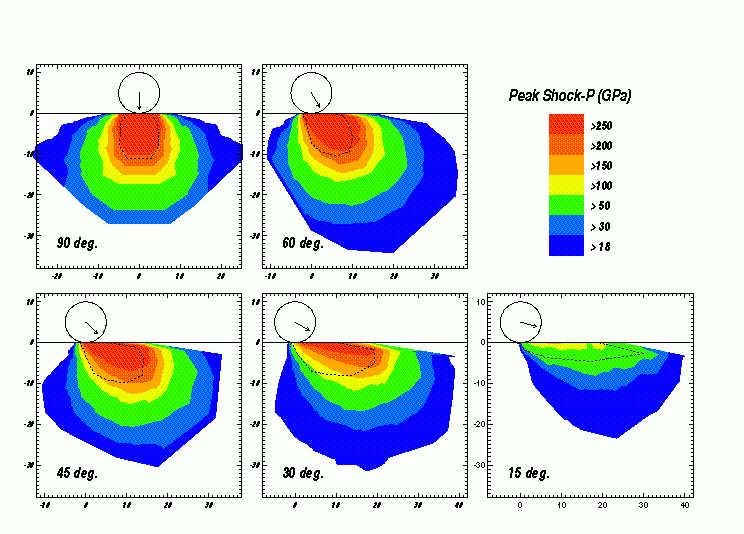
From
- E. Pierazzo, H.J. Melosh. 2000.
"Melt production in oblique impacts".
Icarus 145, pp. 252-261.
To my knowledge, hydrodynamic code (hydrocode) simulations on supercomputers have not been used to study the antipodal effects of oblique impacts. However, it is possible to produce a pattern similar to the Sandia Lab's hydrocode simulation of a vertical impact by using an animation program to perform a simple dynamics simulation. Spherical particles launched in streams from 4 emitters reflect off the inside wall of a cylinder. Except for straight versus arced trajectories, the result is a good match for waves outside the core.
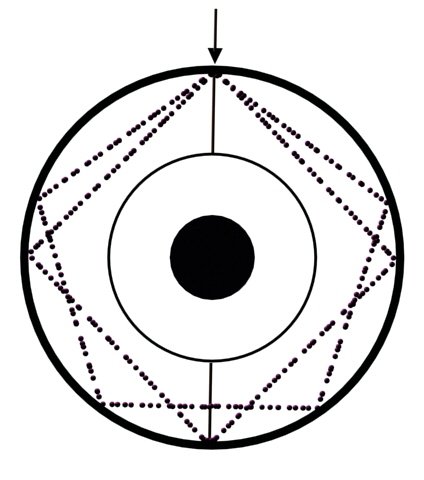
Shifting the emitters slightly (4 degrees) to simulate the off-center energy focus of an oblique impact angle produces this result:
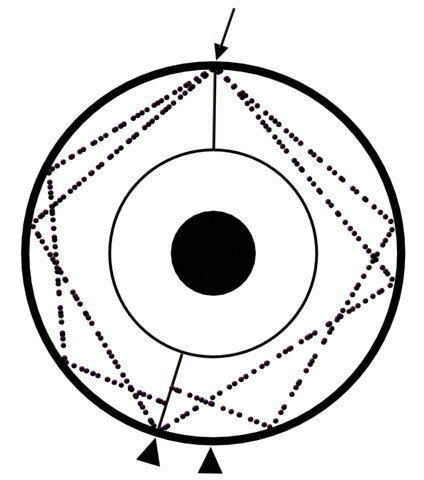
The energy focuses at a new antipodal axis (left black triangle) that is closer to the meteorite along its incoming direction. This simulation and the hydrocode simulation both assume a uniform mantle for simplicity. The actual mantle is heterogeneous, with pockets of varying composition and density.6,8,11,12 This should cause the wave energy to lose some of its focus and affect a broader area.
Seismic tomography allows us to look deep into the Earth, though the images differ according to the methods researchers use to interpret the data. There are two particularly large regions with slow seismic velocities (considered "hot" or "wet") which led to the proposal that "superplumes" rise from the outer core of the Earth. One is under eastern and southern Africa; the other (red-orange below) is centered roughly on the islands of French Polynesia in the Pacific. The South Pacific Superswell is the surface feature, and it looks like a good candidate for antipodal focused energy from the Shock Dynamics meteorite impact. Geologists have not been able to determine its origin. Some believe it to be a cluster of at least 6 small plumes,9 leading to speculation that the southern part "may be related to a rising superplume which has been delayed in the transition zone and then initiated the secondary plumes", whereas the northern part "could also be related to another superplume which is now going down but which was coming up 30-90 million years ago".1 Clearly it is an unusual feature.
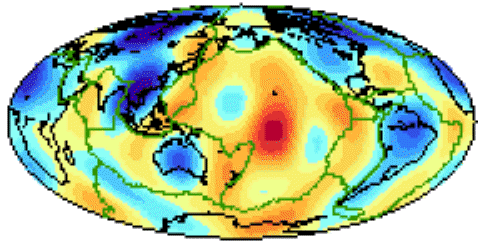
QRLW8, 210 km. Anelastic 3D model of the upper mantle from full seismogram waveform inversion. From: Yuancheng Gung and Barbara Romanowicz, "Q tomography of the upper mantle using three component long period waveforms", Geophys. J. Int., 157, 813-830 (2004).
In the next picture, the dot is the exact antipode of the Shock Dynamics crater north of Madagascar. The gray shape is the South Pacific Superswell.1 The highest terrain, up to 680 meters, is in the dark gray part of the lower portion. The Superswell is slightly closer to the impact crater, consistent with the oblique simulation.
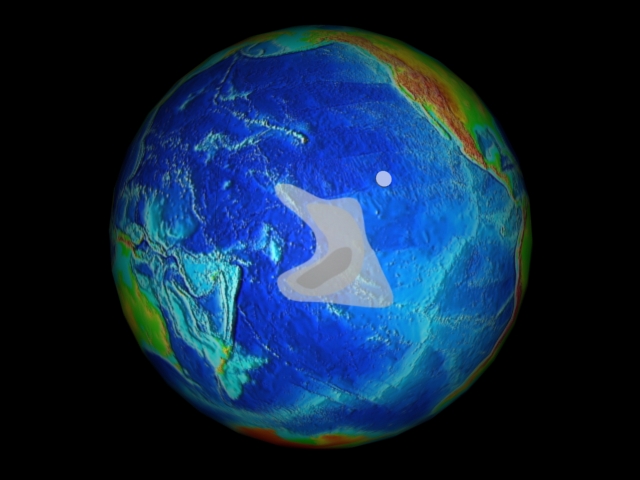
The arrow shows how the Superswell is also in line with the meteorite's ESE azimuth.
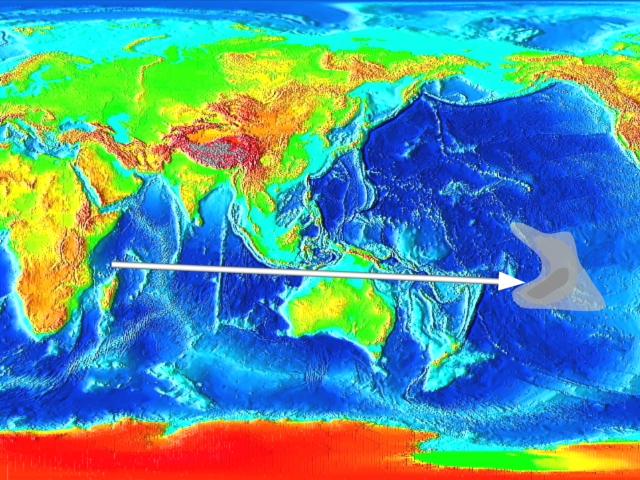
So the South Pacific Superswell is not only the right size but in the right place to be antipodal disruption by the Shock Dynamics giant meteorite impact.
Yet there is another candidate downrange, a third of the distance around the world from the Shock Dynamics giant meteorite impact - the Ontong Java Plateau. Clearly, the Ontong Java Plateau partially obstructed the northern edge of the shock wave that ended as the Tonga-Kermadec Trench. Like the South Pacific Superswell, its distorted semi-circular shape might have resulted from the transmission of pressure waves along oblique paths through the Earth. If so, it surfaced shortly before the shock wave passed.


"On Earth, the largest known flood basalt province is the Ontong Java Plateau (OJP)." "Extending beneath the OJP about 300 km into the mantle is a low-velocity root." "Centered beneath the OJP’s thickest crust,... the root is cylindrical with a diameter of about 745 miles, and is characterized by anomalously slow (about 5%) shear wave velocities. If such velocities were entirely thermal in origin, then the root would be up to 700 degrees Kelvin hotter than surrounding mantle, hot enough to cause continuing volcanism. However, since the OJP shows no evidence of active volcanism, this keel was proposed to more likely represent a chemical heterogeneity." "Shear velocity and attenuation characteristics of the OJP’s anomalous mantle root... rule out a thermal anomaly as its cause, further supporting the idea that the keel represents a chemical heterogeneity." "Taken in total, many geophysical, geodynamic, and geochemical results from the OJP are at odds with various mantle plume models for its origin. The greater OJP cannot be tied convincingly to any hotspot or hotspot track." - Ingle, Stephanie, Millard F. Coffin. 2004. Impact origin for the greater Ontong Java Plateau? Earth and Planetary Science Letters. Vol. 218, pp. 123-134 DOI:10.1016/S0012-821X(03)00629-0
* * * * * * * *
References
1. Adam, Claudia, Alain Bonneville. 2005. Extent of the South Pacific Superswell. Journal of Geophysical Research, Vol. 110, B09408, 14 pages.
2. Boslough, M.B., E.P. Chael, T.G. Trucano, D.A. Crawford, D.L. Campbell. 1996. Axial Focusing of Impact Energy in the Earth's Interior: a Possible Link to Flood Basalts and Hotspots. in The Cretaceous-Tertiary Event and Other Catastrophes in Earth History, G. Ryder, S. Gartner, D. Fastovsky (eds.), GSA Special Paper 307, pp. 541-550.
3. Hagstrum, Jonathan T., 2005. Antipodal hotspots and bipolar catastrophes: Were oceanic large-body impacts the cause? Earth and Planetary Science Letters, 236, pp. 13-27.
4. Melosh, H.J. 2000. Can impacts induce volcanic eruptions? International Conference on Catastrophic Events and Mass Extinctions: Impacts and Beyond, Lunar and Planetary Science Institute Contribution 1053, 2 pages.
5. Pierazzo, E., H.J. Melosh. 2000. Understanding Oblique Impacts from Experiments, Observations, and Modeling. Annual Review of Earth and Planetary Science, Vol. 28, pp. 141-167, (Figure 2 - p. 152).
6. Poupinet, Georges, Nicholas Arndt, Pierre Vacher. 2003. Seismic tomography beneath stable tectonic regions and the origin and composition of the continental lithospheric mantle. Earth and Planetary Science Letters, 212, pp. 89-101.
7. Retailleau, L., N. M. Shapiro, J. Guilbert, M. Campillo, P. Roux. 2014. Antipodal focusing of seismic waves observed with the USArray. Geophysical Journal International, Vol. 199, pp. 1030-1042.
8. Rhodes, Mark, J. Huw Davies. 31 March 2004. Constructing a Geodynamic A Priori Seismic (GAPS) velocity model of upper mantle heterogeneity. Geochemistry Geophysics Geosystems, Vol. 5, No. 3, 12 pages.
9. Schubert, G., G. Masters, P. Olson, P. Tackley. 2004. Superplumes or plume clusters? Physics of the Earth and Planetary Interiors, 146, pp. 147-162.
10. Schultz, Peter H., Raymond R. Anderson. 1996. Asymmetry of the Manson impact structure: Evidence for impact angle and direction. GSA Special Paper 302, pp. 397-417.
11. Trampert, Jeannot, Frederic Deschamps, Joseph Resovsky, Dave Yuen. 29 October 2004. Probabilistic Tomography Maps Chemical Heterogeneities Throughout the Lower Mantle. Science, Vol. 306, pp. 853-856.
12. van der Hilst, Robert D. 29 October 2004. Changing Views on Earth's Deep Mantle. Science, Vol. 306, pp. 817-818.
13. Watts, Alison Weatherly. 1992. The formation of terrains antipodal to major impacts. Master's Thesis, Abstract, Arizona State University, Tempe, AZ.
14. Watts, Alison W., Ronald Greeley, H.J. Melosh. September 1991. The formation of terrains antipodal to major impacts. Icarus, Vol. 93, pp. 159-168.
15. Williams, David A., Ronald Greeley. August 1994. Assessment of Antipodal-Impact Terrains on Mars. Icarus, Vol. 110, Issue 2, pp. 196-202.
www.newgeology.us
2006-2015
John Michael
Fischer